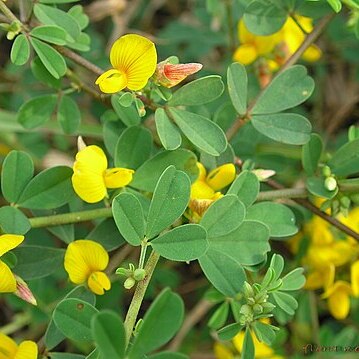Herbs, shrublets, or shrubs, prostrate to erect, to 1 m tall. Stems slender, branched, appressed silky pubescent. Stipules filiform, 2-3 mm. Leaves 3-foliolate; petiole 0.2-2 cm; petiolules ca. 1 mm; leaflet blades oblanceolate, obovate-oblong, or ovate-oblong, (1-)2-3 × 0.3-1.2 cm, abaxially densely silky pubescent, adaxially glabrous, base cuneate, apex obtuse, truncate, or retuse. Racemes terminal or leaf-opposed, many flowered; bracts minute. Pedicel 2-3 mm. Calyx subcampanulate, 2-4 mm, 5-lobed; lobes broadly lanceolate. Corolla yellow; standard elliptic to ovate-oblong, 3-5 mm, base with 2 appendages, apex pilosulose; wings oblong to obovate, 3-4 mm; keel ± as long as wings, rounded and narrowed apically from middle, beak long and twisted. Ovary sessile. Legume globose, 3-5 mm in diam., included in or slightly exserted beyond calyx, pubescent, 2-seeded, apex shortly beaked. Fl. Aug-Oct, fr. Nov-Dec.
More
A herb or small shrub. It can lie along the ground or be erect. It grows 1 m tall. The branches are slender and have silky hairs. The leaves have 3 leaflets. These are oval to oblong and 2-3 cm long by up to 1 cm wide. They have silky hairs underneath. There are many flowers in a group at the ends of branches or opposite the leaves. The flowers are yellow. The pods are round and 3-5 mm across. They have 2 seeds.
Seashore sandy areas, grassy slopes, along trails; at elevations around 100-280 metres. Open places and disturbed areas in deciduous dipterocarp, mixed deciduous, evergreen forests and limestone mountains, at elevations to 2,000 metres.
More
It is a tropical and subtropical plant.
Can be grown by seedlings. Seeds needs soaking.

